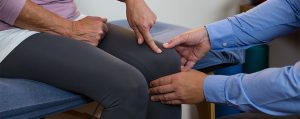Management of Concussion in Sports
It is estimated that as many as 3,900,000 sports and activities-related concussions occur annually in the U.S. A concussion can occur from either a bump, blow, or jolt to the head or body that causes the head and brain to move rapidly back and forth, either from a fall, a collision of players, or impact from the ground or other obstacles. Collision sports are at the highest risk for concussions, but any athletic activity remains a risk.
Overuse Foot and Ankle Injuries in Gymnasts
Foot and ankle injuries can occur during various sports, but a shoe or cleat may protect the foot from more severe injuries. However, some sports are performed barefoot, such as gymnastics. Gymnasts have high demands on their feet and ankle, especially when landing their skills on vault, bars, floor, and beam. Gymnastics places high impact forces and high repetitions on growing young athletes. Gymnasts train all year and are therefore susceptible to overuse injuries.
So Your Baseball Season is Done….Now What?
If you know anything about youth baseball, the season seems never ending as kids go from one team to another and never seem to have an offseason. Most youth baseball players and parents don’t realize that the offseason is equally if not more important than the regular season. It is a chance for the body to recover and adapt to the changes that were imposed on it during the regular season. Now the offseason does not mean it’s time to sit around and do nothing; it’s a great chance to improve your strength and conditioning and address asymmetries as well as faults in your throwing motion.
What Are the Different Levels of an ACL Tear?
There are 250,000 anterior cruciate ligament ruptures in the United States every year1. The anterior cruciate ligament (ACL) is one of four major stabilizing ligaments of the knee. The ACL, along with the posterior cruciate ligament (PCL), medial collateral ligament (MCL), and lateral collateral ligament (LCL), play crucial roles in helping the knee function normally. When one or more of these ligaments is injured, daily activities such as going up and down stairs or walking across uneven terrain can become more challenging. Similarly, an injury to one or more knee ligament(s) can make running, cutting, or jumping difficult in sports. Not all ACL injuries are created equal, as some are more severe than others. Let’s take a look at how ACL injuries are classified.
The Basics: Sprains, Strains, and Fractures…What’s The Difference?
“I sprained my hamstring!” “I didn’t break it. I fractured it.” “He had a bad ankle strain.” Physical therapists, occupational therapists, and most medical professionals cringe when we hear this at parties, in the media, or our clinic. The tactful among us do their best to resist the urge to correct, but let’s face it, we are only human.
Return to Sport vs. Return to Work
The American Physical Therapy Association describes Physical Therapists as “movement experts who improve quality of life through prescribed exercise, hands-on care, and patient education.” As physical therapists, with our patient’s help, we shape their goals around what improves their specific quality of life. Often, we picture athletes returning to sports or patients relearning how to walk. Less commonly, we think about the importance of injured workers returning to their jobs without limitations. It’s easy to understand why the rehabilitation process for return to sport is so intense and personalized for a patient. The rehabilitation process for return to work should be just as intense and personalized to assist the employee in reaching their goals.
Top Areas to Foam Roll for Gymnasts
Warm-up and recovery are important parts of a workout routine that often get overlooked. A dynamic warm-up prepares the body prior to exercise; conversely, recovery or cooling down after exercise can help manage soreness. Active recovery is a great option to help manage normal muscle soreness symptoms after high-intensity workouts. It is normal to have muscle soreness after high- intensity exercise; this can last for several hours up to several days. Active recovery may help reduce muscle soreness and fatigue.
How to Succeed in PT following ACL Reconstruction Surgery
“I don’t really have the words right now, definitely not the right ones at least,” this was the quote from Odell Beckham Jr. following his 2nd ACL tear during Superbowl LVI. Most people know that an ACL tear is a common knee injury that requires a long, tenacious recovery. Once an ACL is torn, the risk of re-tear or tearing the opposite side is 20-35% more likely4. The above statistic may be alarming and is why ACL reconstruction rehabilitation needs to be taken very seriously.
